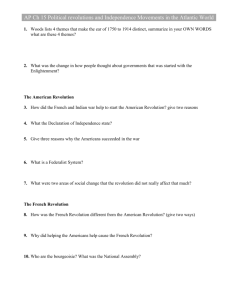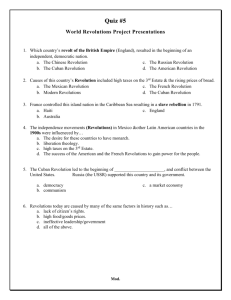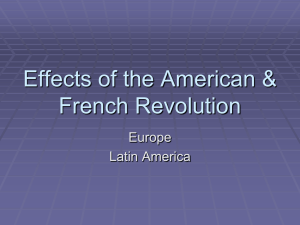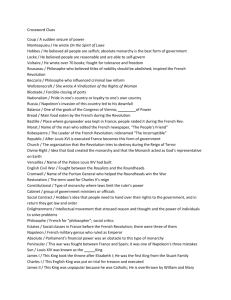New Political Ideas and Revolutions
advertisement
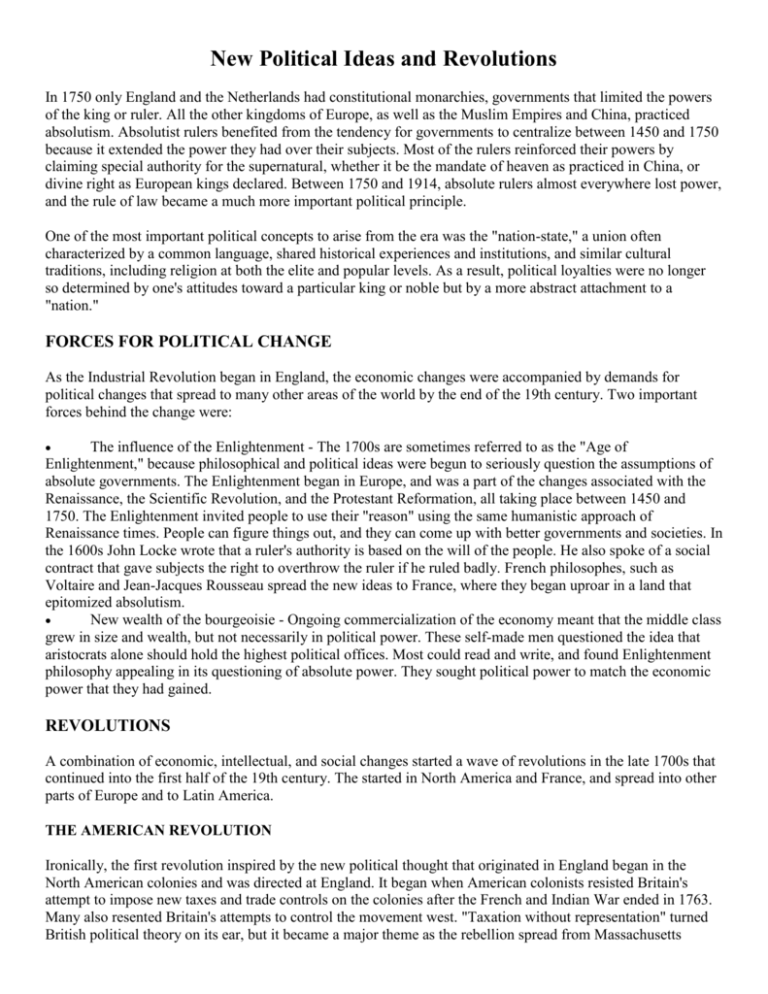
New Political Ideas and Revolutions In 1750 only England and the Netherlands had constitutional monarchies, governments that limited the powers of the king or ruler. All the other kingdoms of Europe, as well as the Muslim Empires and China, practiced absolutism. Absolutist rulers benefited from the tendency for governments to centralize between 1450 and 1750 because it extended the power they had over their subjects. Most of the rulers reinforced their powers by claiming special authority for the supernatural, whether it be the mandate of heaven as practiced in China, or divine right as European kings declared. Between 1750 and 1914, absolute rulers almost everywhere lost power, and the rule of law became a much more important political principle. One of the most important political concepts to arise from the era was the "nation-state," a union often characterized by a common language, shared historical experiences and institutions, and similar cultural traditions, including religion at both the elite and popular levels. As a result, political loyalties were no longer so determined by one's attitudes toward a particular king or noble but by a more abstract attachment to a "nation." FORCES FOR POLITICAL CHANGE As the Industrial Revolution began in England, the economic changes were accompanied by demands for political changes that spread to many other areas of the world by the end of the 19th century. Two important forces behind the change were: The influence of the Enlightenment - The 1700s are sometimes referred to as the "Age of Enlightenment," because philosophical and political ideas were begun to seriously question the assumptions of absolute governments. The Enlightenment began in Europe, and was a part of the changes associated with the Renaissance, the Scientific Revolution, and the Protestant Reformation, all taking place between 1450 and 1750. The Enlightenment invited people to use their "reason" using the same humanistic approach of Renaissance times. People can figure things out, and they can come up with better governments and societies. In the 1600s John Locke wrote that a ruler's authority is based on the will of the people. He also spoke of a social contract that gave subjects the right to overthrow the ruler if he ruled badly. French philosophes, such as Voltaire and Jean-Jacques Rousseau spread the new ideas to France, where they began uproar in a land that epitomized absolutism. New wealth of the bourgeoisie - Ongoing commercialization of the economy meant that the middle class grew in size and wealth, but not necessarily in political power. These self-made men questioned the idea that aristocrats alone should hold the highest political offices. Most could read and write, and found Enlightenment philosophy appealing in its questioning of absolute power. They sought political power to match the economic power that they had gained. REVOLUTIONS A combination of economic, intellectual, and social changes started a wave of revolutions in the late 1700s that continued into the first half of the 19th century. The started in North America and France, and spread into other parts of Europe and to Latin America. THE AMERICAN REVOLUTION Ironically, the first revolution inspired by the new political thought that originated in England began in the North American colonies and was directed at England. It began when American colonists resisted Britain's attempt to impose new taxes and trade controls on the colonies after the French and Indian War ended in 1763. Many also resented Britain's attempts to control the movement west. "Taxation without representation" turned British political theory on its ear, but it became a major theme as the rebellion spread from Massachusetts throughout the rest of the colonies. Colonial leaders set up a new government and issued the Declaration of Independence in 1776. The British sent forces to put the rebellion down, but the fighting continued for several years until the newly created United States eventually won. The United States Constitution that followed was based on enlightenment principles, with three branches of government that check and balance one another. Although initially only a few had the right to vote and slavery was not abolished, the government became a model for revolutions to come. THE FRENCH REVOLUTION A very different situation existed in France. No established nobility existed in the United States, so when independence was achieved, the new nation had no old social and political structure to throw off. In contrast, the Revolution in France was a civil war, a rising against the Ancien Regime, or the old kingdom that had risen over centuries. The king, of course, had absolute power, but the nobility and clergy had many privileges that no one else had. Social classes were divided into three estates: first was the clergy, second the nobility, and the Third Estate was everyone else. On the eve of the Revolution in 1789, about 97% of the population of France was thrown into the Third Estate, although they held only about 5% of the land. They also paid 100% of the taxes. Part of the problem was that the growing class of the bourgeoisie had no political privileges. They read Enlightenment philosophes, they saw what happened in the American Revolution, and they resented paying all the taxes. Many saw the old political and social structure as out of date and the nobles as silly and vain, undeserving of the privileges they had. The French Revolution began with King Louis XVI called the Estates-General, or the old parliamentary structure, together for the first time in 160 years. He did so only because the country was in financial crisis brought on by too many wars for power and an extravagant court life at Versailles Palace. Many problems converged to create the Revolution: the nobles' refusal to pay taxes, bourgeoisie resentment of the king, Louis Vic's incompetence, and a series of bad harvests for the peasants. The bourgeoisie seized control of the proceedings and declared the creation of the National Assembly, a legislative body that still exists in France today. They wrote the Declaration of the Rights of Man and the Citizen, modeled after the American Declaration of Independence, and they set about to write a Constitution for France. The years after the revolution began were turbulent ones that saw the king beheaded and the government taken over by the Jacobins, a radical group that sought equality through executing those that disagreed with the government. The Reign of Terror lasted for about two years, with thousands of people guillotined and thousands more fleeing the country. The Jacobin leaders themselves were eventually guillotined; the country teetered for several years in disarray, and finally was swept up by Napoleon Bonaparte as he claimed French glory in battle. Democracy did not come easily in France. CONSERVATIVE REACTION TO REVOLUTION Napoleon Bonaparte, of minor nobility from the island of Corsica, rose through the ranks of the French military during a time of chaos. He seized the French Government at a time when no one else could control it. He promised stability and conquest, and by 1812 the French Empire dominated Europe to the borders of Russia. His invasion of Russia was unsuccessful, done in by cold winters, long supply lines, and Tsar Alexander It's burn and retreat method that left French armies without food. Finally, an alliance of European countries led by Britain defeated Napoleon in 1815 at Waterloo in modern day Belgium. Although Napoleon was defeated and exiled, other countries were horrified by what had happened in France: a revolution, the beheading of a king, a terrorizing egalitarian government, and finally a demagogue who attacked all of Europe. To conservative Europe, France was a problem that had to be contained before their ideas and actions spread to the rest of the continent. The allies that had defeated Napoleon met at Vienna in 1815 to reach a peace settlement that would make further revolutions impossible. The Congress of Vienna was controlled by the representatives of three nations: Britain, Austria, and Russia. Each country wanted something different. The British wanted to destroy the French war machine, Russia wanted to establish an alliance based on Christianity, and Austria wanted a return to absolutism. They reached an agreement based on restoring the balance of power in Europe, or the principle that no one country should ever dominate the others. Rather, the power should be balanced among all the major countries. France actually came out rather well in the proceedings, due in large part to the talents of their representative, Tallyrand. However, the Congress restricted France with these major decisions: Monarchies - including the monarchy in France - were restored in countries that Napoleon had conquered France was "ringed" with strong countries by its borders to keep its military in check. The Concert of Europe was formed, an organization of European states meant to maintain the balance of power. THE SPREAD OF REVOLUTION AND NEW POLITICAL IDEAS No matter how the Congress of Vienna tried to stem the tide of revolution, it did not work in the long run. France was to wobble back and forth between monarchy and republican government for thirty more years, and then was ruled by Napoleon III (Bonaparte's nephew) until 1871, when finally a parliamentary government emerged. And other countries in Europe, as well as colonies in Latin America, had heard "the shot heard round the world," and the true impact of the revolutionary political ideas began to be felt. REVOLUTIONS IN LATIN AMERICA From North America and France, revolutionary enthusiasm spread throughout the Caribbean and Spanish and Portuguese America. In contrast to the leaders of the War for Independence for the United States, most of the early revolutions in Latin America began with subordinated Amerindians and blacks. Even before the French Revolution, Andean Indians, led by Tupac Amaru, besieged the ancient capital of Cuzco and nearly conquered the Spanish army. The Creole elite responded by breaking the ties to Spain and Portugal, but establishing governments under their control. Freedom, then, was interpreted to mean liberty for the property-owning classes. Only in the French colony of Saint Domingue (Haiti) did slaves carry out a successful insurrection. The rebellion in 1791 led to several years of civil war in Haiti, even though French abolished slavery in 1793. When Napoleon came to power, he sent an army to tame the forces led by Toussaint L'Ouverture, a former slave. However, Napoleon's army was decimated by guerrilla fighters and yellow fever, and even though Toussaint died in a French jail, Haiti declared its independence in 1804. Other revolutions in Latin America were led by political and social elites, although some of them had important populist elements. Brazil - Portugal's royal family fled to Brazil when Napoleon's troops stormed the Iberian Peninsula. The presence of the royal family dampened revolutionary fervor, especially since the king instituted reforms in administration, agriculture, and manufacturing. He also established schools, hospitals, and a library. The king returned to Portugal in 1821, after Napoleon's threat was over, leaving Brazil in the hands of his son Pedro. Under pressure from Brazilian elites, Pedro declared Brazil's independence, and he signed a charter establishing a constitutional monarchy that lasted until the late 19th century when Pedro II was overthrown by republicans. Mexico - Father Miguel Hidalgo led Mexico's rebellion that eventually led to independence in 1821. He was a Catholic priest who sympathized with the plight of the Amerindian peasants and was executed for leading a rebellion against the colonial government. The Creole elite then took up the drive for independence that was won under the leadership of Agustin de Iturbide, a conservative military commander. However, Father Hidalgo's cause greatly influenced Mexico's political atmosphere, as his populist ideas were taken up by others who led the people in revolt against the Creoles. Two famous populist leaders were Emiliano Zapata and Pancho Villa, who like Father Hidalgo were executed by the government. Mexico was not to work out this tension between elite and peasants until well into the 20th century. Spanish South America - Colonial elite - landholders, merchants, and military - also led Spanish colonies in South America in rebellion against Spain. The term "junta" came to be used for these local governments who wanted to overthrow colonial powers. Two junta centers in South America were: 1. Caracas, Venezuela - At first, laborers and slaves did not support this Creole-led junta. However, they were convinced to join the independence movement by Simon de Bolivar, a charismatic military leader with a vision of forging "Gran Columbia," an independent, giant empire in the northern part of South America. He defeated the Spanish, but did not achieve his dream of empire. Instead, regional differences caused the newly independent lands to split into several countries. 2. Buenos Aires, Argentina - Another charismatic military leaders - Jose de San Martin - led armies for independence from the southern part of the continent. His combined Chilean/Argentine forces joined with Bolivar in Peru, where they helped the northern areas to defeat the Spanish. Martin's areas, like those led by Bolivar, also split along regional differences. All in all, constitutional experiments in North America were more successful than those in South America. Though South Americans gained independence from colonial governments during the 19th century, their governments remained authoritarian and no effective legislatures were created to share the power with political leaders. Why this difference? COMPARATIVE CONSTITUTIONAL EXPERIMENTS; NORTH AMERICA AND SOUTH AMERICA NORTH AMERICA Mother country had parliamentary government, so colonial governments had a constitutional model SOUTH AMERICA Mother country governed by absolute monarch; colonial governments had authoritarian model Colonies had previous experience with popular politics; had their Colonies had no experience with popular own governments that often operated independently from British politics; colonial governments led by control authoritarian Creoles Military leaders were popular and sometimes became Presidents Had difficulty subduing the power of military (Washington, Jackson), but they did not try to take over the leaders; set in place the tradition of military government as military leaders; constitutional principle that juntas taking over governments military would be subordinate to the government Latin American Revolutions occurred during American Revolution occurred in the 1770s; vulnerable new the early 1800s, a time when the world nation emerged at an economically advantageous time, when the economy was contracting, a less world economy was expanding advantageous time for new nations The differences in political backgrounds of the two continents led to some very different consequences. For the United States (and eventually Canada), it meant that relatively democratic governments left entrepreneurs open to the Industrial Revolution, which, after all, started in their mother country. For Latin America, it meant that their governments were less supportive and/or more removed from the economic transformations of the Industrial Revolutions, and stable democratic governments and economic prosperity would be a long time in coming. IDEOLOGICAL CONSEQUENCES OF REVOLUTIONS The Enlightenment philosophy that inspired revolutions in the United States, France, and Latin America brought about lasting changes in western political ideology, with some people reacting against the chaos that revolutions brought, and others inspired by the values of democracy, liberty, equality, and justice. Three contrasting ideologies may be seen by the early 1800s: Conservatism - People who supported this philosophy at first advocated return to absolute monarchy, but came to accept constitutional monarchy by the mid-1800s. Generally, conservatives disapproved of the revolutions of the era, particularly the French Revolution with all the violence and chaos that it brought. Liberalism - Liberals supported a republican democracy, or a government with an elected legislature who represented the people in political decision-making. These representatives were generally from the elite, but were selected (usually by vote) from a popular base of citizens. Emphasis was generally on liberty or freedom from oppression, rather than on equality. Radicalism - Radicals advocated drastic changes in government and emphasized equality more than liberty. Their philosophies varied, but they were most concerned with narrowing the gap between elites and the general population. The Jacobins during the French Revolution, and Marxism that appeared in the mid 19th century were variations of this ideological family. REFORM MOVEMENTS The political values supported by revolutions were embraced by some who saw them as applying to all people, including women and former slaves. Values of liberty, equality, and democracy had profound implications for change within societies that had always accepted hierarchical social classes and gender roles. Reform movements sprouted up as different people put different interpretations on what these new political and social values actually meant. Women's Rights Advocates of women's rights were particularly active in Britain, France, and North America. Mary Wollstonecraft, an English writer, was one of the first to argue that women possessed all the rights that Locke had granted to men, including education and participation in political life. Many French women assumed that they would be granted equal rights after the revolution. However, it did not bring the right to vote or play major roles in public affairs. Since gender roles did not change in the immediate aftermath of revolution, social reformers pressed for women's rights in North America and Europe. Americans like Elizabeth Cady Stanton and Susan B. Anthony in the United States decided to concentrate their efforts on suffrage, or the right to vote. A resolution passed at Seneca Falls, New York, in 1848, emphasized women's rights to suffrage, as well as to education, professional occupations, and political office. Their movement did not receive popular support, however, until the 20th century, but their activism laid a foundation for large-scale social change later. The Limits of the Abolitionist Movement Although slavery was abolished in Europe and North America by the late 19th century, blacks did not realize equality within the time period. Although former slaves were guaranteed the right to vote in the late 1860s in the United States, they were effectively barred from political participation by state and local legislation called Jim Crow laws. Blacks all over the Americas tended to have the least desirable jobs, limited educational opportunities, and lower social status than whites. Conservative Reactions to Reform During the late 1800s two systems of related political thought emerged among conservatives to justify inequalities: Scientific racism - This idea system became popular among conservative thinkers in industrialized societies. It used scientific reasoning and evidence to prove its premise that blacks are physiologically and mentally inferior to whites. The theory generally constructed three main "races" in the world - Caucasian, Mongoloid, and Negroid, and built its arguments that basic differences existed among them that made Negroids inherently inferior to Caucasians. Scientific racism, then, justified the inferior positions that blacks had in the society and the economy. Social Darwinism - This philosophy justified not racial differences, but differences between the rich and the poor. It used Darwin's theory of natural selection (living things that are better adapted to the environment survive, others don't) to explain why some get rich and others remain poor. In the competition for favored positions and bigger shares of wealth, the strong, intelligent, and motivated naturally defeat the weak, less intelligent, and the lazy. So, people who get to the top deserve it, as do the people who remain at the bottom Marxism Another reaction to the revolution in political thought was Marxism, The father of communism is generally acknowledged to be Karl Marx, who first wrote about his interpretation of history and vision for the future in The Communist Manifesto in 1848. He saw capitalism, or the free market, as an economic system that exploited workers and increased the gap between the rich and the poor. He believed that conditions in capitalist countries would eventually become so bad that workers would join together in a Revolution of the Proletariat (workers), and overcome the bourgeoisie, or owners of factories and other means of production. Marx envisioned a new world after the revolution, one in which social class would disappear because ownership of private property would be banned. According to Marx, communism encourages equality and cooperation, and without property to encourage greed and strife, governments would be unnecessary. His theories took root in Europe, but never became the philosophy behind European governments, but it eventually took new forms in early 20th century Russia and China. NATIONALISM In older forms of political organizations, the glue of political unity came from the ruler, whether it is a king, emperor, sultan, or caliph. Political power generally was built on military might, and a ruler controlled the land that he conquered as long as he controlled it. Power was often passed down within one family that based the legitimacy of their rule on principles that held sway over their populations, often some kind of special contact with the spiritual world. The era 1750 to 1914 saw the creation of a new type of political organization - the nation - that survived even if the rulers failed. Whereas nations' political boundaries were still often decided by military victory, the political entity was much broader than control by one person or family. Nations were built on nationalism - the feeling of identity within a common group of people. Of course, these feelings were not new in the history of the world. However, the force of common identity became a basic building block for nations, political forms that still dominate world politics today. Nationalism could be based on common geographical locations, language, religion, or customs, but it is much more complex than that. The main idea is that people see themselves as "Americans" or "Italians" or "Japanese," despite the fact that significant cultural variations may exist within the nation. Napoleon contributed a great deal to the development of strong nationalism in 19th century Europe. His conquests were done in the name of "France," even though the French monarchy had been deposed. The more he conquered, the more pride people had in being "French." He also stirred up feelings of nationalism within a people that he conquered: "Germans" that could not abide being taken over by the French. In Napoleon's day Germany did not exist as a country yet, but people still thought of themselves as being German. Instead Germans lived in a political entity known as "The Holy Roman Empire." However, the nationalism that Napoleon invoked became the basis for further revolutions, in which people around the world sought to determine their own sovereignty, a principle that Woodrow Wilson called self-determination.



